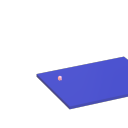3rd Release Candidate of ELSE 1.0-0 (with Live Electronics Tutorial)
HEY!!! I'm really proud of this one.
This took kind of a while so there's lots and lots of new stuff and breaking changes. This is the 1st release to reach and exceed 450 objects (459 in total now, next milestone, 500 objects?). Total number of examples in the tutorial is now 477. Here are the release's highlights:
- MOST ESPECIALLY, WE FINALLY HAVE DECENT COMPILED BANDLIMITED OSCILLATORS ([bl.saw~], [bl.tri~], [bl.vsaw~], [bl.square~],[bl.imp~], [bl.imp2~]) thanks to Tim Schoen from PlugData, who has become a great partner in the development of ELSE, since ELSE is part of PlugData
 This was one of the last milestones for a proper final release, so maybe we're close. BTW, I have to say that the oscillators from ELSE are the only ones I know out there that have BOTH hard sync input AND phase modulation input. I don't know any other not only in Pd, but in MAX, SuperCollider, Csound, Chuck, Reaktor, whatever...
This was one of the last milestones for a proper final release, so maybe we're close. BTW, I have to say that the oscillators from ELSE are the only ones I know out there that have BOTH hard sync input AND phase modulation input. I don't know any other not only in Pd, but in MAX, SuperCollider, Csound, Chuck, Reaktor, whatever... - Now we have a new [numbox~] GUI compiled object for monitoring and generating signals (this replaces [diisplay~], which was removed). This is thanks to Tim Schoen again.
- The [bicoeff] object has been renamed to [bicoeff2] and [bicoeff] is now a new GUI object based on the "filtergraph" external (this one is still very experimental and not really acceptable yet).
- All objects with random generators have been revised to take a seed value and generate unique seeds every time you open the patch. I made a PR to Pure Data so we have something similar for [random], [noise~] and [array random].
- [brown~] has an impulse signal input to generate random steps now as well.
- There are 13 new objects, most importantly and not yet mentioned: [brown] (control browninan motion), [bl.osc~] (a band limited oscillator based on wavetables), [blip~] (a bandlimited impulse generator) and [scala] (for importing tunings in the Scala software format).
Complete changelog is here: https://github.com/porres/pd-else/releases/tag/v1.0-rc3
It's up on deken, have fun.
PolyBLEP / BLEP / BLIT etc with oscillator sync
@nuromantix For reference:
PolyBLEP triangle
http://www.martin-finke.de/blog/articles/audio-plugins-018-polyblep-oscillator/
https://www.kvraudio.com/forum/viewtopic.php?t=375517
Hard Sync without Aliasing in this thread:
https://forum.pdpatchrepo.info/topic/5507/antialiasing/7
Did someone do aliasing-free sync without filter in pd yet?
Contribute to better Pd Documentation
@porres said in Contribute to better Pd Documentation:
On the other hand. If you want a new tutorial like the FLOSS one for 'vanilla' as part of its official documentation, then we need to work on it from scratch, and there'll be no need for a FLOSS version that lives in flossmanuals.net! And I think that can easily be included as part of the Pd Vanilla distribution and its online documentation.
So, went to have a look as to what would it take to make the FLOSS tutorials ported to vanilla... and... well, it seems that despite using Extended, some of the examples are pretty much 'vanilla friendly' (no externals). These can be easily ported then...
But where are the authors these days? I know Derek Holzer is one, but he was just recently sayin on the facebook group that the FLOSS manuals is old should be forgotten himself... If we were to update it in the web, who would do it? And could we revise it and change it and take or put stuff?
Well, I'm thinking about copying the basic tutorials here into a new one, fully vanilla, to be downloadable via deken. But... I guess it'll be kinda "based on this", because I have a few issues with some of the things we have here.
For instance, [phasor~] is described as an osccllator, and it is not one in the sense you can plug it in and listen to it as it has a DC Offset. I will suggest that we even change the description in the help object from 'sawtooth' generator to 'phase ramp' generator. Oscillators need to go from -1 to 1. The square oscillator there is also a pulse train instead. And these are not band limited oscillators (so pretty bad and aliased ones) and we should say that...
Also, in ampplitude modulation, I don;t think it's a good classical example to modulate it to a phasor~ signal, an [osc~] should be much better. And the 'tremolo' effect should also have a 'depth' parameter so it can be called an actual tremolo. A tremolo is not just amplitude modulation with a low frequency.
So if I were to design a new and quick, simple, new tutorial for newcomers, I know I'd change a lot of things... so the problem I have with it is not that it's just old and outdated, but also with the content, which I think can be greatly improved.
I created a new issue on github https://github.com/pure-data/pure-data/issues/1331#issuecomment-850893517
strange oscillation in [hip~ 1]
I noticed this oddity while using a [phasor~] at low frequencies to ping a resonant filter: [hip~] oscillates quietly for cutoff frequencies below 20. You also get an interesting "zing" when you step its input between DC levels.
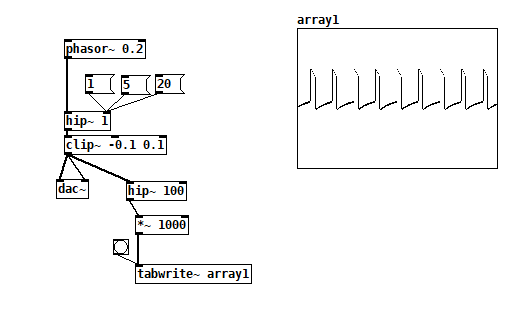
hip~ 1 oscillation.pd
No biggie, just something weird I noticed. I bet the math behind it is interesting.
Trying to reproduce a sound with Pd
@jameslo Analog components all have tolerances, +- 10% is not uncommon for pots, so any of the knobs between the two modules could be 20% off from each other given a worse case scenario, plus all those other components in the module could make it even further off, Generally circuits are designed to minimize the effects of component tolerances and high tolerance parts will be used in critical locations like frequency but amplitude and PW are not critical location, our ears will not notice small differences here. On top of that components age and their value changes, so two 30 year old modules can be very different despite once being identical. Things like phase and frequency are not constants in the analog world, things drift and oscillators which share a power source tend to sync when they get close. Most have to be very close in frequency to sync this way, the beat frequency will be well under 1hz but under certain situations you can hear it if you listen close. When trying to copy a patch from the analog world in the digital, knobs can only be used as a rough guide, need to use your ears.
When you distorted the wave you added harmonics and changed the strengths of the old harmonics, only harmonics of equal strength but opposite phase will cancel fully. You most likely did have cancellation just not full cancellation (depends on how you distorted it). Put both oscillators to the same frequency and opposite phase, listen to the distorted one and then add in the undistorted oscillator, you should hear a decrease in harmonic content from the cancellation. This will be most apparent with low to moderate levels of distortion, the more distortion, the more harmonics you are adding, the less the two waves have in common, and as a result less gets canceled.
Edit: didn't quite finish that last sentence.
additive sine-synth thing
I was watching some of miller's videos on the internals of pd and got inspired to try a different (probably processing intensive) method of parallel processing for multiple oscillators/additive synthesis & came up with this ugly thing after some hours. Basically it uses upsampling to use every "location" in a block as a separate oscillator. (so sample 2 in a block is oscillator 2, etc.) The subpatch is upsampled x64 with 64 block size so every sample 1 sample of 64 oscillators are being processed. [tabsend~] and [tabreceive~] are used for storing the phase of the sine waves in-between samples. It's probably relatively heavy on the processing. still I thought it was kinda cool.
If anyone knows how to get the sum of all samples in a block in vanilla that would also be helpful (I'm using [rfft~] now but don't need to do an entire fft just for the sum)
additive.pd
Synthesis OSC
@8v01d You are using only ring modulation. You can change by adding frequency modulation (it is very powerful and can create very interesting sounds) to some carrier oscillators but not all. Also you could split the output of each oscillator right before the envelope into 2 channels (one left and one right to have stereo). Then you could change the envelope to be different in the stereo section. Also you could use different kinds of oscillators (sine, triangle, saw, square etc.). You made it clear and i like that. Nice.
NoxSiren - Modular synthesizer system <- [v15]
NoxSiren is a modular synthesizer system where the punishment of failure is the beginning of a new invention.
--DOWNLOAD-- NoxSiren for :
-
Pure Data :
NoxSiren v15.rar
NoxSiren v14.rar -
Purr Data :
NoxSiren v15.rar
NoxSiren v14.rar
--DOWNLOAD-- ORCA for :
- x64, OSX, Linux :
https://hundredrabbits.itch.io/orca
In order to connect NoxSiren system to ORCA system you also need a virtual loopback MIDI-ports:
--DOWNLOAD-- loopMIDI for :
- Windows 7 up to Windows 10, 32 and 64 bit :
https://www.tobias-erichsen.de/software/loopmidi.html
#-= Cyber Notes [v15] =-#
- added BORG-IMPLANT module.
- introduction to special modules.
- more system testing.
#-= Special Modules [v15] =-#
- BORG-IMPLANT (connects ORCA MIDI system to NoxSiren system)
#-= Current Modules [v15] =-#
- VCO (voltage-controlled-oscillator)
- VCO2 (advance voltage-controlled-oscillator)
- WAVEBANK (additive synthesis oscillator)
- ADSR (Attack-Decay-Sustain-Release envelope)
- C-ADSR (Curved Attack-Decay-Sustain-Release envelope)
- CICADAS (128 steps-Euclidean rhythm generator)
- CICADAS-2 (advance 128-steps polymorphic-Euclidean rhythm generator)
- COMPRESSOR (lookahead mono compressor unit)
- DUAL-COMPRESSOR (2-channel lookahead mono compressor unit)
- STEREO-COMPRESSOR (lookahead stereo compressor unit)
- MONO-KEYS (virtual 1-voice monophonic MIDI keyboard)
- POLY-KEYS-2 (virtual 2-voice polyphonic MIDI keyboard)
- POLY-KEYS-3 (virtual 3-voice polyphonic MIDI keyboard)
- POLY-KEYS-4 (virtual 4-voice polyphonic MIDI keyboard)
- POLY-KEYS-5 (virtual 5-voice polyphonic MIDI keyboard)
- POLY-KEYS-6 (virtual 6-voice polyphonic MIDI keyboard)
- BATTERY (simple manual triggered machine for drumming.)
- REVERB (reverb unit with lowpass control)
- STEREO-REVERB (stereo reverb unit with lowpass control)
- RESIN (advanced rain effect/texture generator)
- NOISE (generates black,brown,red and orange noise)
- NOISE2 (generates yellow,blue,pink and white noise)
- COBALT (6-stage polyrhythm generator)
- SHAPER (basic shaper unit)
- FOLDER (basic wave folding unit)
- STEREO-FOLDER (stereo wave folding unit)
- DUAL-FOLDER (advance wave folding unit)
- POLARIZER (transform a signal into bi-polar, uni-polar, inverted or inverted uni-polar form)
- CLOCK (generates a BPM clock signal for sequencing other modules)
- CLOCKDIVIDER (a clock divider with even division of clock signal)
- CLOCKDIVIDER2 (a clock divider with odd division of clock signal)
- DELAY-UNIT (delay unit)
- STEREO-DELAY (stereo delay unit)
- CHORUS (chorus unit)
- STEREO-CHORUS (stereo chorus unit)
- SEQ (advance 16-step/trigger sequencer)
- KICK (synthesize kick unit)
- KICK2 (synthesize flavor of KICK module)
- KICK3 (synthesize flavor of KICK module)
- SNARE (synthesize snare unit)
- CLAP (synthesize clap unit)
- CYMBAL (synthesize cymbal unit)
- RAND (RNG generator for other modules parameters)
- FMOD (feedback modulation unit)
- AM (amplitude modulation unit)
- RM (ring modulation unit)
- LFO (low-frequency-oscillator)
- LFO2 (advance low-frequency-oscillator)
- COMBINATOR (combine two waves)
- COMBINATOR2 (combine three waves)
- COMBINATOR3 (combine four waves)
- STRING (Karplus-Strong string synthesis unit)
- STRING2 (advance Karplus-Strong string synthesis unit)
- DETUNER (parametric 4-channel detuner unit)
- CRUSHER (basic audio resolution unit)
- STEREO-CRUSHER (basic stereo audio resolution unit)
- DUAL-CRUSHER (advance audio resolution unit)
- FILTER (basic filter)
- VCF (voltage-controlled-filter)
- MAR (Moog-analog-resonant filter)
- VCA (voltage-controlled-amplifier)
- DUAL-VCA (advance voltage-controlled-amplifier)
- FMUX (multiplexer with fast A/D internal envelope)
- MMUX (multiplexer with medium A/D internal envelope)
- SMUX (multiplexer with slow A/D internal envelope)
- FDMX (demultiplexer with fast A/D internal envelope)
- MDMX (demultiplexer with medium A/D internal envelope)
- SDMX (demultiplexer with slow A/D internal envelope)
- MIXER (mix 1-4 possible waves)
- SCOPE (oscilloscope analyzer)
- MASTER (fancy DAC~)
- BOX (useless decorative module)
NoxSiren integrated modules menu system.
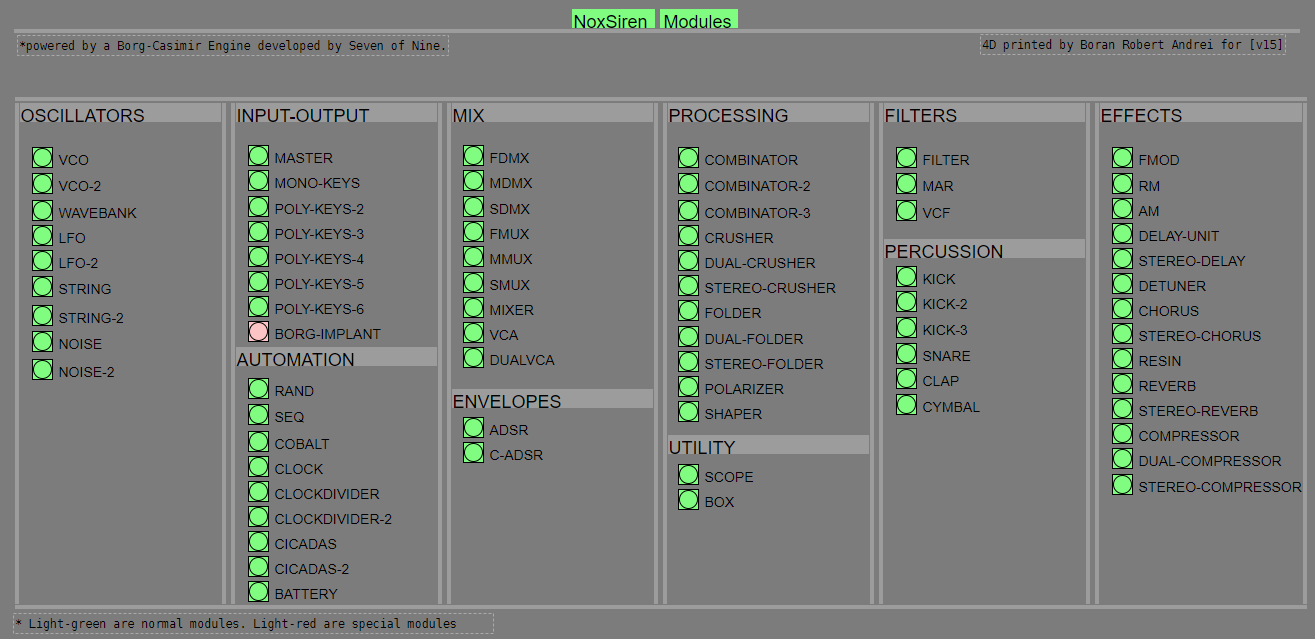
Smooth frequency transition
you should use a logarithmic line~ object to adjust the curve as smooth as you want.
On top of that you should apply a Nyquist correction to the output of your oscillator abstraction.
So here you have some imagines how to do that. The Nyquist abstraction is used in the output of the triangle oscillator abstraction as an example. Then the final output can be controlled with a logarithmic line~ object.
OBS : If you need more then one oscillator you can apply this for each oscillator and then use a mixer and then the output of the mixer you use again the same idea. In this way you have an oscillator smooth stage control and a final mixer stage control for extra smoothness.
This is just the simple mono smooth control (no curve adjustment)
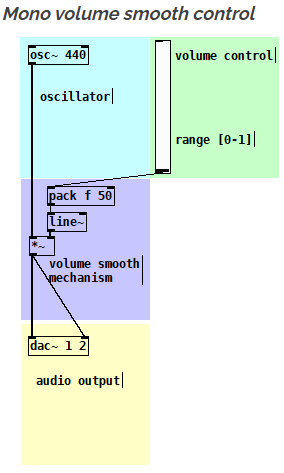
The same idea but as a stereo version
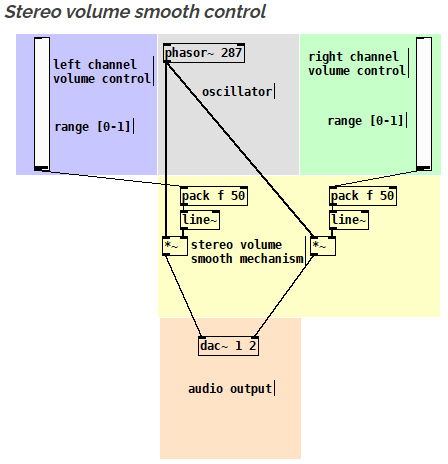
Here is with logarithmic smooth control (with curve adjustment)
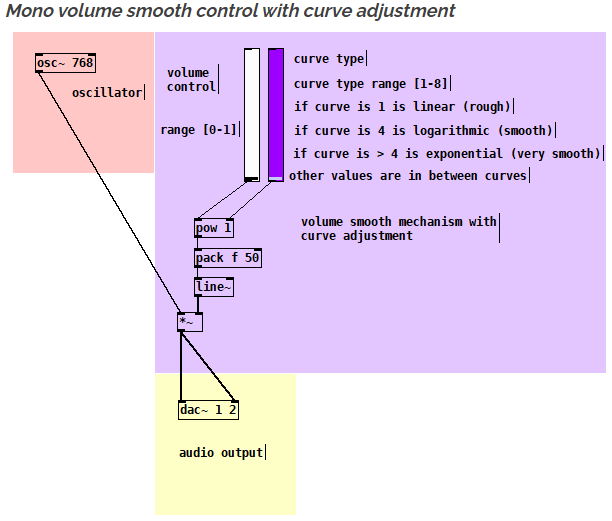
Here you have a Nyquist correction abstraction
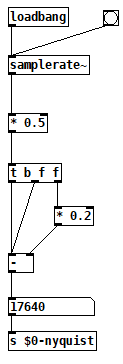
Here you have a triangle oscillator with Nyquist correction
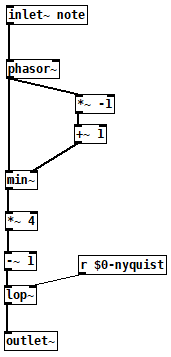
You can also download xline~ which is an object that is doing just that :
https://forum.pdpatchrepo.info/topic/13084/xline-logarithmic-line-object
Unable to get FM saws?
@randal I hacked up your patch a little so I could run it to see what was going on, in particular I removed the algorithm switch from the voice and just took signal from the carrier. Is this not the result you were looking for?

Note that both oscillators are at the same pitch, and I took care to start them at the same time so they'd be in the same phase. I also think you might have accidentally deleted the feedback path for the modulating oscillator. [edit: I see now that you didn't, but the feedback outlet is post amp attenuation, so there is very little feedback. Additionally, you are using s~/r~ which introduces a 64 sample delay--consider using the technique in my next post]
I only have a passing knowledge of FM, but it seems like you have to keep the modulation index (in your case, op2 amp) really low to get the results you're looking for. I don't know how the DX modulation indexes are scaled. Also, if you're evaluting your results in time domain (i.e. looking at the wave shape) I think the phase between the oscillators is important. Adjusting the tuning of the oscillators while they're running will shift their phase relative to each other.

